Filling rules for household gas cylinders at gas stations: safety standards and requirements
A gas bottle in a summer cottage or in a country house is a familiar phenomenon, but extremely troublesome. After all, the supply of blue fuel in them will have to be periodically restored, observing the rules for refueling household gas cylinders at gas stations. And the cylinders themselves must meet special conditions.
You will learn all about the norms and requirements for filling tanks with liquefied gas from the article we presented. We will talk about which cylinders are suitable for refueling and further operation, where and how to make it better. We will warn about the problems most often associated with this event.
The content of the article:
- And what does the law say?
- Danger of filling cylinders at gas stations without a license
- Types and features of gas storage cylinders
- Inspection of cylinders. How to find out the service life
- Why you should not refuel at usual gas stations?
- Services of gas filling stations
- Rules for refueling cylinders
- Which is better: exchange or refueling?
- Replacement Procedure, Transport Safety
- Several important operating nuances
- Conclusions and useful video on the topic
And what does the law say?
Gas stations, gas distribution stations and other gas supply facilities belong to the most difficult operational category. The legislation provides for strict safety rules, in accordance with which all actions are carried out at the facilities and the adjacent territory.
The storage and operation of a gas cylinder in the domestic sphere is explained by Decree of the Government of the Russian Federation dated December 26, 2016 No. 1498. It governs the provision of utilities and the operation of common property. One of the items describes the issues of purchase, refueling and exchange of household gas cylinders.
Important Highlights Important for Everyone types of gas cylinders:
- the cylinder must be in good condition;
- have unexpired shelf life;
- sale is carried out only in special licensed points;
- refueling is carried out at gas filling stations.
It follows that at ordinary automobile gas filling stations, refueling is prohibited by the rules for the design and use of equipment operating under pressure. And this is not a whim of the law, but a real act of caring for citizens.
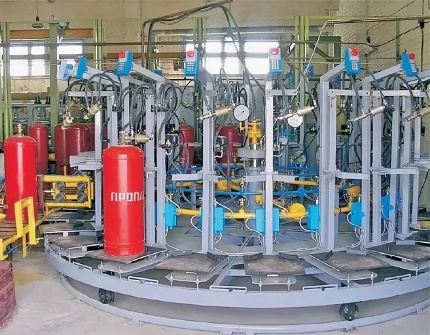
Danger of filling cylinders at gas stations without a license
The fact is that household and automobile cylinders differ in design: the latter have special shutoff valves that do not allow overfilling of the tank.
The gas supply system shuts off automatically when the norm is reached (no higher than 85%). And in cylinders, the purpose of which is domestic use, such cutoffs are not provided. Another nuance is that automobile systems are filled in liters, and household ones in kilograms.
In licensed "gas-filling stations" this issue is solved simply - the cylinder is filled on the scales. Everything is done taking into account the amount of residues and newly supplied gas. The tank itself must be checked for leakage, life, the presence of residues of heavy fractions.
Since 2017, at ordinary gas stations for cars, household gas cylinders have stopped refueling. On the one hand, it is clear that after several emergency situations with explosions, government bodies paid attention to this problem. However, on the other hand, they have not yet been able to solve it completely due to a lack of licensing points.
And if when contacting a car Gas station you will be filled with a balloon, know: you and the gas station violate the law.
Let us consider what legal possibilities we have for filling a cylinder with gas, what are the basic rules according to which gas cylinders are refueled for Gas station, as well as other important information on the operation of gas equipment with removable media.
Types and features of gas storage cylinders
Manufacturers produce several types of steel cylinders of different volumes: 5, 15, 25 and 50 liters. Weight - from 4 to 22 kg. For example, a 50 liter cylinder weighs 44 kg. Recently, cylinders made of polymer composite materials in volumes of 14 or 33 liters have been developed and produced.
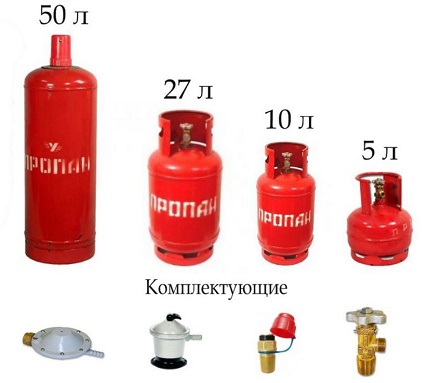
Types of tanks for domestic use
According to the material from which the body is made, cylinders for domestic use are divided into the following groups:
- Steel cylinders - strong and durable. Their vulnerability is welding seams, that is why when buying and examining welding seams, much attention is paid. It is recommended to choose the right place for the installation of equipment, excluding places of high humidity, so as not to corrode steel models.
- Composite containers. This is a more modern option. Composite Gas Cylinder It is also quite durable, costs 2-3 times more expensive due to the high cost of materials containing fiberglass. Enhances durability additional protection of the housing.
Polymer cylinders are easier to transport, as they weigh less and are less subject to deformation upon impact or falling. Another advantage of polymer equipment is high heat resistance. It may be near the fire.
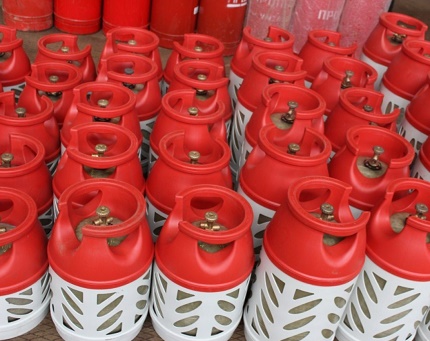
How do color and purpose compare?
According to the rules of GOST, the color of the cylinder determines their purpose:
- white with yellow inscriptions fill with acetylene;
- red - for propane;
- blue - for medical or ordinary oxygen;
- they store hydrogen in dark green;
- in gray with black elements - nitrous oxide.
For use in our living conditions and regular replenishment of liquefied petroleum reserves, only red tanks with the corresponding marking are suitable.
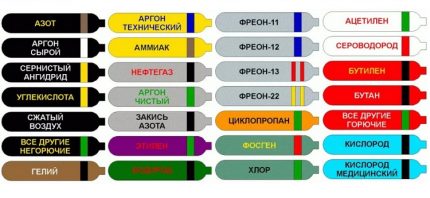
Inspection of cylinders. How to find out the service life
Household propane cylinders are metal sealed containers of a certain volume for storing gas. The material of manufacture is a steel alloy with the addition of chromium and molybdenum. From the manufacturer, they fall into free circulation. They are used in specialized companies as equipment, in enterprises, in everyday life among the population.
Each cylinder is accompanied by the issuance of a paper passport from the manufacturer. Data is duplicated in the form of metal inscriptions on the back of the case, next to the hallmark of the enterprise.
The technical condition of the cylinders should be strictly monitored in accordance with GOST 15860. An examination procedure is carried out to determine the possibility of further operation.
Subject to a survey once every five years:
- products released before February 2014 can last up to 40 years;
- products manufactured after February 1, 2014 - up to 20 years.
The “metal passport” indicates the date of manufacture of the product, volume, weight, date of the last survey. According to the rules of use, cylinders without metal passports or with fuzzy inscriptions are not refueling and cannot be exchanged.
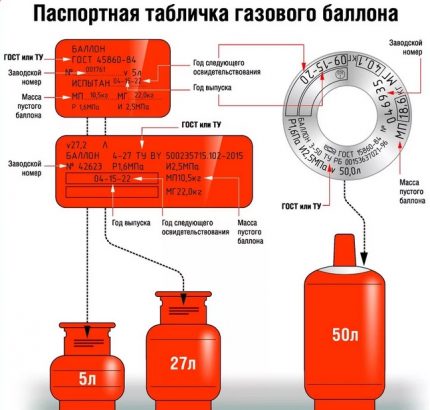
And it is right. The “life” of each cylinder proceeds differently: some products are in constant use, while others may gather dust in the garage for years to be used for certain purposes at the right time.
Do not forget that faulty equipment for storing hazardous substances (gas) can cause trouble.
Why you should not refuel on ordinary Gas station?
The question of whether it is possible to refuel domestic gas cylinders at gas stations, it is worth considering in more detail. According to the law, it is only possible to sell liquefied gas at specially equipped points. But many car gas stations, bypassing the law, are trying to make money on it.
When purchasing gas at such a gas station, consumers should remember not only legal liability, but also the danger posed by an incorrectly filled cylinder.
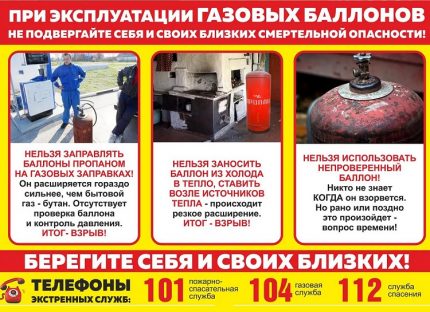
And the risks are great if:
- capacity is not checked for leaks;
- inspection control, and therefore serviceability, is not carried out;
- but the most important thing is that at gas stations there is no way to check the occupancy rate provided for by the approved standards (85% of the volume).
The free zone creates a “steam cap” that prevents gas expansion. For example, when heated under the sun. How much liquid substance is needed is easy to calculate by dividing the nominal volume by 1.43. For example, for a cylinder designed for 22 liters, it is enough to add 15.38 liters of liquefied gas.
If there is no shut-off device, the work is carried out literally “by eye”, therefore there is a great possibility of overflowing the tank, and therefore, increasing the possibility of catastrophic risk.
Therefore, before filling an empty gas cylinder on Gas station, make sure that the item has special equipment for this, including a weighing scale. But it is better to fill the tanks at special gas filling stations to ensure guaranteed weight control.
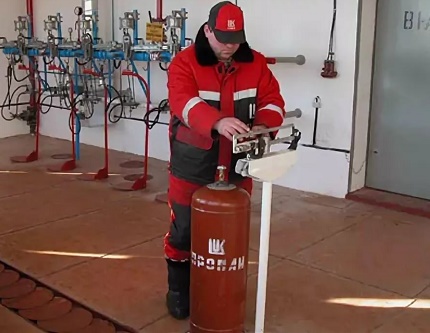
Services of gas filling stations
These are companies that refuel gas in any authorized containers. The gas filling station must be equipped with special equipment that determines the method of gas filling.
There are three ways to refuel:
- pumping;
- pump and compression;
- pump and evaporative.
The name of the equipment speaks for itself. These are pumps, compressors for creating high pressure, an evaporator, heater for providing high pressure. Also should be present: hoods, gas storage tanks, technical equipment (density meters, dispensers).
A mobile modular station is an option of a small gas distribution station for refueling oxygen cylinders, most often used for medical institutions or construction enterprises that use oxygen for welding.
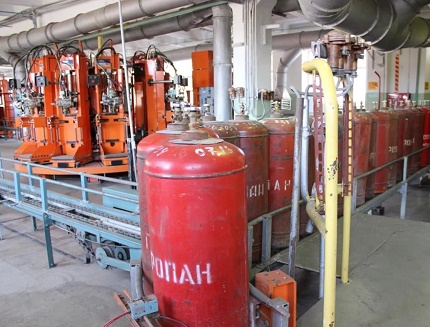
Large stations use cylinder filling stations with electronic weighing systems, including an industrial controller and a gas supply valve. When installing the container on the cargo receiving platform of the scale, the amount of residues and the mass of the new receipt are automatically recorded.
Upon reaching the desired volume set in advance on the electronic unit, the gas supply automatically stops.
Rules for refueling cylinders
Safety requirements apply to refueling a standard cylinder. Mandatory marking "compressed gas" and a special sticker signal an explosion hazard.
Equipment must be checked according to the following parameters:
- serviceability;
- the presence of residual pressure;
- valve or valve defects;
- the presence of rust on the surface, peeling of the material;
- dents or damage.
Before refueling, condensate and gas residues are removed from the cylinder, it is checked for good condition.
At specialized stations, inventory is used - a hose for gas with valves, an adapter - adapter.
Which is better: exchange or refueling?
Get the gas bottle you need to work gas boiler, stoves, outdoor lighting lines, etc., in two ways: refuel your tank or exchange it for another, already refueled.
In the first case, the cylinders are left at the station for 1-2 days, the consumer receives his full container.
In the second - a quick exchange of empty capacity to full. Consumers themselves can choose which way to use. The second method is faster, but you get someone else’s equipment, perhaps not the latest. The cost depends on the type and volume of gases. Standard case: 200-300 rubles.
What problems may lurk when refueling
Nuances that are important to know about filling gas cylinders:
- Some Chinese cylinders have thin walls. They are not designed for heavy loads. It must be remembered that cheap equipment may not pay off due to high risk.
- Active gases are prone to fire and explosions, therefore, it is especially necessary to carefully monitor the volume (85%) when filling with propane, oxygen, methane.
- To use household gas at low temperatures, it is better to use winter mixtures of propane butane, with the advantage of propane, since butane is unsuitable for winter operation.
In order to prevent the occurrence of these problems and risks associated with the replenishment of the stock of liquefied explosive substances, it is necessary to think over the process in advance and provide for all the nuances.
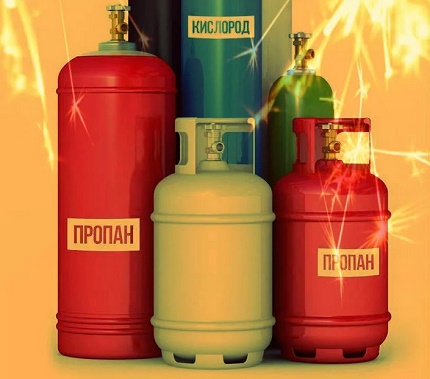
Replacing the cylinder with a new one, repair
Sooner or later, the cylinder wears out, the valve may fail, the surface will begin to delaminate. Almost every city has a replacement or repair point for cylinders. You can give old and get a new product, with an extra charge of about 1,500 rubles. This is a good alternative to buying new equipment.
If the valve is to be repaired, it must be repaired or completely change. The cylinder itself can be sanded and painted. The cost of a new empty cylinder for propane: from 2,500 to 600 rubles, depending on the materials of the manufacturer.
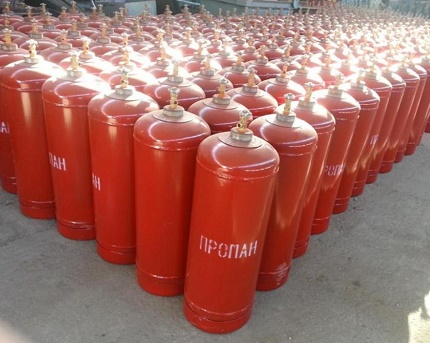
Replacement Procedure, Transport Safety
The design of the cylinders differs by the presence of a closing valve KB-2 or technical valve VB-2 according to GOST 21804–94. In versions with a valve, there is a quick-detachable reducer, which reduces the pressure when a flame occurs.
The gearbox is attached to the main hose through a fitting with a small mounting clamp:
- The gearbox is attached to the cylinder with the valve by pulling it on the neck of the valve with an o-ring.
- It is connected to the valve by means of a thread on the valve union, in another case, by a union nut of the gearbox. At replacement points, a special disposable gasket is issued.
If the gas pressure has decreased markedly and goes to "no", do not squeeze it to the last drop:
- Turn off the gas, turn off the valve and begin replacing the cylinder.
- Remember that the gearbox has left-hand threads. Unscrew the gear nut clockwise.
- Replace the cylinder.
- Cook paronite gasket for replacement. Tighten the nut counterclockwise. The cylinder should stand strictly upright (never turn it over).
- Be sure to close the tap of the old cylinder, put the plug and protective cap. This is important because a certain volume of gas always remains in the cylinder.
Always shut off the faucet if the stove does not work.
Transportation of cylinders is carried out only with safety caps and caps. When transporting, check that the crane is closed and protected by a cap.
Several important operating nuances
Simple rules will help you to conveniently and safely use cylinders in cottages and in country houses:
- Do not smoke when replacing the bottle. It is forbidden to keep open fire close by, to check leakage by means of fire (lighters or matches).
- Keep the valve fully open, and with the devices turned off, completely closed.
- Do not operate the power tool in close proximity to the cylinder so that sparks conductive rotor brushes did not flash when a gas leak was imperceptible.
Compliance with the requirements for the competent and accurate operation of liquefied gas tanks is the norm that guarantees the safety of the user and others, as well as the safety of property.
With the nuances and rules for filling gas cartridges required for the operation of the burners, familiarize next article. We recommend reading some very useful information.
Conclusions and useful video on the topic
Gas station fifty-liter balloon. Specialized gas stations have the necessary equipment. Cylinders are necessarily checked for integrity, the valve is inspected. Refueling time is approximately 5-10 minutes. Observed safety precautions:
Use gas equipment carefully. Try to protect the housing from shock in order to prevent gas leakage:
After replacing the cylinder, inspect and evaluate the density of the connections, make sure there are no gas leaks. You can coat the compounds with foam from a soap solution and observe:
A gas stove is the best option for domestic use when there is no centralized gas pipeline. Knowing how to properly fill a gas cylinder on Gas station with the necessary equipment, performing safety during transportation and operation, you can make life comfortable and convenient.
Share your experience gained while refueling a household cylinder with the most affordable type of fuel? Do you have useful information on the topic of the article, which is worth sharing with visitors to the site? Please leave comments in the block below, ask questions, post a photo.

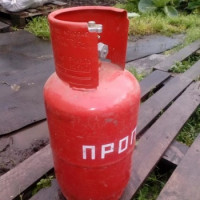 Refueling household gas cylinders: rules for filling, servicing and storing cylinders
Refueling household gas cylinders: rules for filling, servicing and storing cylinders  Gas cylinder cabinet: cylinder storage requirements + cabinet selection and installation tips
Gas cylinder cabinet: cylinder storage requirements + cabinet selection and installation tips  Characteristics of typical 50 liter gas cylinders: design, dimensions and weight of the cylinder
Characteristics of typical 50 liter gas cylinders: design, dimensions and weight of the cylinder  Types of gas cylinders: full classification + analysis of labeling
Types of gas cylinders: full classification + analysis of labeling 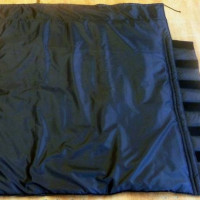 How does a thermal blanket work for gas cylinders: features of the device and use + selection tips
How does a thermal blanket work for gas cylinders: features of the device and use + selection tips 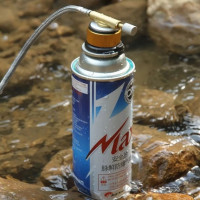 Do-it-yourself gas cans for burners: instructions for different types of cylinders
Do-it-yourself gas cans for burners: instructions for different types of cylinders  How much does it cost to connect gas to a private house: the price of organizing gas supply
How much does it cost to connect gas to a private house: the price of organizing gas supply  The best washing machines with dryer: model rating and customer tips
The best washing machines with dryer: model rating and customer tips  What is the color temperature of light and the nuances of choosing the temperature of the lamps to suit your needs
What is the color temperature of light and the nuances of choosing the temperature of the lamps to suit your needs  Replacement of a geyser in an apartment: replacement paperwork + basic norms and requirements
Replacement of a geyser in an apartment: replacement paperwork + basic norms and requirements
Hello. I arrived at a gas station to fill a cylinder with propane, they demand a “subscription book” from me. Although when selling the cylinder I was told that nothing was needed for subsequent refueling. This is normal?!